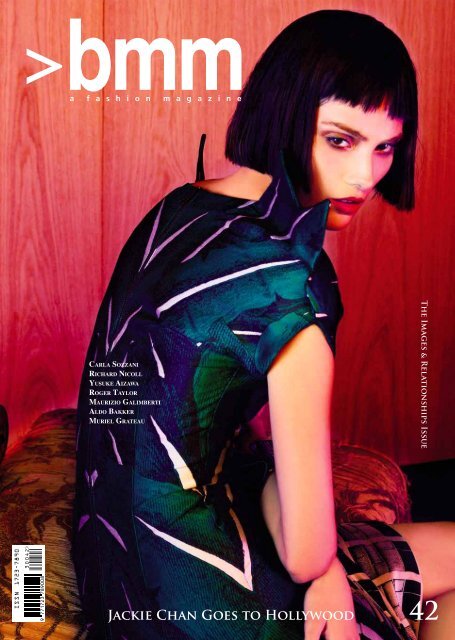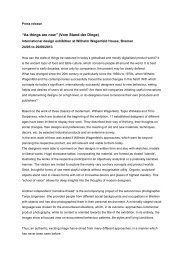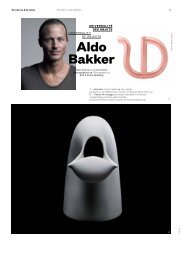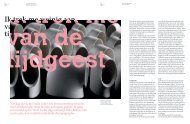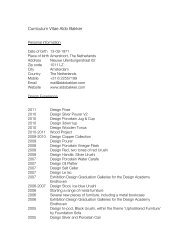Jackie Chan Goes to Hollywood - Aldo Bakker
Jackie Chan Goes to Hollywood - Aldo Bakker
Jackie Chan Goes to Hollywood - Aldo Bakker
You also want an ePaper? Increase the reach of your titles
YUMPU automatically turns print PDFs into web optimized ePapers that Google loves.
Carla SozzaniRichard NicollYusuke AizawaRoger TaylorMaurizio Galimberti<strong>Aldo</strong> <strong>Bakker</strong>Muriel GrateauThe Images & Relationships Issue<strong>Jackie</strong> <strong>Chan</strong> <strong>Goes</strong> <strong>to</strong> <strong>Hollywood</strong>42
A DIVINE LEGACYIl suo lavoro va al di là del tempo, fluttuando tra passa<strong>to</strong> e futurocome ci aspetta da un innova<strong>to</strong>re, consegnando oggetti che sono differentiper forme e materiali. <strong>Aldo</strong> <strong>Bakker</strong> si fa intimo con il design.Text > Massimo De Conti Portrait and all Pho<strong>to</strong>s > Erik en Petra HesmergQuando incontro <strong>Aldo</strong> <strong>Bakker</strong> ho l’impressione ditrovarmi di fronte ad un essere poco terreno. Saràforse la figura eterea associata ad un’altezza fuoridal comune a (tras)portarlo fuori dalla dimensioneumana. O magari è per via del suo lavoro, della suamano che disegna forme sinuose ed essenziali acui dona la terza dimensione scegliendo materialiinsoliti e ricercati. Oggetti di uso quotidiano conechi di strumenti musicali e utensili antichi chenon sfigurerebbero nelle mani di qualche diopagano. <strong>Bakker</strong>, figlio d’arte dei visionari Gijs -co-fonda<strong>to</strong>re della Dutch collective Droog Design- e della creatrice di gioielli Emmy van Leersum,continua nel suo studio ad Amsterdam il percorsotraccia<strong>to</strong> dai geni<strong>to</strong>ri nel mondo del design.Con un segno che sembra sospeso tra mondoclassico e contemporaneità, ma con una forteconnotazione innovativa, quest’ultima da sempretrat<strong>to</strong> distintivo dei <strong>Bakker</strong>.Quale è il significa<strong>to</strong> di design?Provo ad evitare di farmi troppe domande suldesign, l’arte o l’architettura. Mi piace esprimereme stesso attraverso la materia, i materiali, lecomposizioni, le forme, colori e linee. Unodovrebbe piut<strong>to</strong>s<strong>to</strong> cercare di interrogarsi suqualsiasi cosa, partendo dal concet<strong>to</strong> che tut<strong>to</strong>potrebbe essere differente.Che connotazione temporale ha il tuo lavoro,del passa<strong>to</strong> o del futuro?Buona domanda. Il mio modo di lavorare nonrifugge dal concet<strong>to</strong> di tempo, ma mi piace usarloin maniera consapevole. Lo sviluppo del miodesign ne richiede mol<strong>to</strong> e spero che il risulta<strong>to</strong>non sia solo una moda o una tendenza…Diresti che stai seguendo il solco traccia<strong>to</strong> daituoi geni<strong>to</strong>ri?Anche se volessi, non potrei sfuggire il fat<strong>to</strong> cheesista. Essendo il figlio di due artisti devo sempreconfrontarmi con le diverse opinioni della gente,ma soprattut<strong>to</strong> con uno specifico pregiudizio: “Nonsarà mai così bravo come ... ”. Devi sempre darprova di te stesso, cercando di fare meglio o, forse,in modo differente. La formazione ricevuta dallamia famiglia ha una grande influenza su di me.Com’è sta<strong>to</strong> crescere in quel tipo di ambienteartistico?Mi sono forma<strong>to</strong> parecchio e ho visita<strong>to</strong> mostre intut<strong>to</strong> il mondo. Sono cresciu<strong>to</strong> tra musei, gallerie,simposi e conferenze che peraltro non mi piacciononeanche poi tan<strong>to</strong>.Quando i miei amici venivano a trovarmi a casaero soli<strong>to</strong> essere orgoglioso della mia famiglia.Sapevo che la realtà in cui vivevo era mol<strong>to</strong>diversa da quella degli altri bambini.I tuoi geni<strong>to</strong>ri hanno comincia<strong>to</strong> a lavorareinsieme negli anni ‘60, ci sono differenze tra iltuo e il loro design?Cer<strong>to</strong> che ci sono delle differenze, ma allo stessotempo il loro lavoro è buona parte delle miefondamenta. Descriverei me stesso come un artistache lavora su un’opera a ritmo costante e stacercando di entrare sempre più in contat<strong>to</strong> con ilproprio io, per meglio capire la sottile linea rossanel suo lavoro. Il mio modo di lavorare è mol<strong>to</strong>simile a quello di mia madre, anche se è difficileaffermarlo da<strong>to</strong> che lei è morta quando io erotroppo giovane per poter ricordare. Gijs, d’altrocan<strong>to</strong>, è più preso a cercare di capire a comereagire allo spiri<strong>to</strong> del tempo.Sei ambizioso?Credo di sì; si diventa un po’ dipendenti a creare…Allora come te la cavi con la tua ambizione inques<strong>to</strong> periodo di crisi economica globale?Per quan<strong>to</strong> riguarda la crisi, è più che altroun’ambizione interiore, e quindi si ha sempreun pubblico - se non altro immaginario! Dalpun<strong>to</strong> di vista degli affari non ci sono problemidal momen<strong>to</strong> che i miei lavori richiedono tempoper essere realizzati e ques<strong>to</strong> crea un ponte mol<strong>to</strong>più lungo di una crisi. Diciamo che rientrano inun’area che non sembra esserne mol<strong>to</strong> colpita.Ti piacciono i materiali inusuali, non direiinnovativi, ma sicuramente inusuali…I materiali sono per me secondari e non sono lacosa più importante. Un design non si sviluppain base al materiale che intendi usare, ma avereesperienza sull’uso di un cer<strong>to</strong> materiale èsicuramente di aiu<strong>to</strong>. Ho bisogno di capire ilvero significa<strong>to</strong> di un materiale e ques<strong>to</strong> è unprocesso che richiede tempo. In ques<strong>to</strong> modo ilmio rappor<strong>to</strong> con esso si fa intimo e il risulta<strong>to</strong> èdefinitivamente più esplici<strong>to</strong>.Quale è la cosa più importante nel tuo lavoro?Hmm… L’elemen<strong>to</strong> più importante nel processo didesign è in rappor<strong>to</strong> stesso con ciò che creo.Un altro aspet<strong>to</strong> mol<strong>to</strong> importante è che i lavoriraggiungano un naturale tipo di esistenza.Trai ispirazione dall’arte?Assolutamente sì! Ricavo un sacco d’ispirazioneanche dall’architettura e dalla musica.L’Olanda e il Belgio sono i centridell’avanguardia del design di moda. Cosapotrei trovare aprendo il tuo guardaroba?Troveresti sicuramente un sacco di Margiela.E ques<strong>to</strong> è mol<strong>to</strong> prevedibile per un designer![Risata.]Permettimi di farti una domanda che avrà forseun’altra risposta prevedibile: quale è il tuosenso preferi<strong>to</strong>?La vista.Ah, mi aspettavo che rispondessi il tat<strong>to</strong>...No, è assolutamente la vista!>136
mmDESIGN>137>>
mmDESIGNOpposite page: Silverware, Salt cellar, design: 2007, material: 100% fine silver_gold plated inside,production: Jan Matthesius; distribution: Thomas Eyck.Porcelain , Jug + Cup_Five different colors, design: 2011, material:porcelain, made by Frans Ottink, representation: Particles Gallery.Porcelain, Water carafe, design: 2007, material: porcelain,production: Frans Ottink, distribution: Thomas Eyck.Urushi Series, Side table, design: 2008, material: Lilac Urushi,Urushi lacquering: Mariko Nishide, Urushi supplier: TakuoMatsuzawa, Joboji Urushi Sangyo, represented: Particles Gallery.Wood, Indigo Tonus s<strong>to</strong>ol, design 2010, handmade out of a solidblock of oak wood by Rutger Graas, represented by Particles.>138
mmDESIGNHis works gobeyond time, floatingacross the past and thefuture: that’s what weexpect from an innova<strong>to</strong>rlike him, who givesus objects which aredifferent in forms andmaterial. <strong>Aldo</strong> <strong>Bakker</strong> getsintimate with design.When I met <strong>Aldo</strong> <strong>Bakker</strong> I had the impression offinding myself in front of an otherworldly creature.Maybe because of his ethereal figure, associated withis uncommon height, which carries him out of thehuman dimension.Or perhaps it is because of his work, drawn with ahand that creates supple and essential shapes. Andhe deliberately adds an extra dimension <strong>to</strong> them bychoosing unusual and elaborate materials. His designsare objects for daily use, but with echoes of musicalinstruments and ancient utensils, that you could easilyfind in the hands of a pagan god. The son of twoartistic visionaries – Gijs, co-founder of the DutchCollective Droog Design, and the jewellery designerEmmy van Leersum – <strong>Bakker</strong> follows the same pathin the world of design that his parents once tracedfrom his studio in Amsterdam. He is now leaving amark that seems <strong>to</strong> be temporally suspended betweenthe classical and contemporary worlds, thoughwith a strong innovative streak, which is the maindistinguishing feature of the <strong>Bakker</strong> family.What does design mean?I try <strong>to</strong> avoid questioning myself on design, art orarchitecture <strong>to</strong>o much. I like <strong>to</strong> express myself throughmatters, materials, compositions, shapes, colours andlines. I would rather say that one should wonder abouteverything, starting by the concept that it could be allcompletely different.Does your work have connotations of time, both thepast and the future?Good question. With my way of working I do notintend <strong>to</strong> escape time, but I like <strong>to</strong> use it in a veryconscious way. My design takes time <strong>to</strong> develop and Ihope that the result is neither a fashion nor a trend.Would you say that you are following the legacy ofyour parents?Even if I wouldn’t, I could not escape the fact that itexists. I am the son of two artists and I always have<strong>to</strong> face different opinions of people, but most of all Ihad <strong>to</strong> deal with one specific prejudice: “he will neverbe as good as ...”. You always have <strong>to</strong> prove yourself,by trying <strong>to</strong> be better or perhaps different. My familybackground has a very big influence on my life.What was it like growing up in such an artisticenvironment?I trained a lot and I visited exhibitions all over theworld. I grew up between museums, galleries,symposia and lectures, which I did not even like thatmuch. When my friends were visiting my house I used<strong>to</strong> be proud of my family. I knew my reality was a lotdifferent from that of other kids.Your parents started <strong>to</strong> work <strong>to</strong>gether in the ’60s,are there any differences between their design andyours with regard <strong>to</strong> the different times?Of course there are but, at the same time, their work isa huge part of my foundations. I would describe myselfas an artist who works on an oeuvre with a constantrhythm, as I try <strong>to</strong> get closer and closer <strong>to</strong> my own self,<strong>to</strong> better understand and learn the thin red line withinmy work. My way of working is very similar <strong>to</strong> mymother’s, although I find this quite hard <strong>to</strong> say becauseshe died when I was <strong>to</strong>o young <strong>to</strong> remember. Gijs, onthe other hand, is more involved in understanding how<strong>to</strong> react <strong>to</strong> the zeitgeist.Are you ambitious?I believe so; you get a bit addicted <strong>to</strong> creating…So, how does your ambition cope or relate with thisperiod of global economic crisis?Concerning the crisis, it is most of all an innerambition, and hopefully you always have an audience- at least an imaginary one! Businesswise, there areno problems since my works demands time and thiscreates a bridge, which is longer than a crisis and itdeals with an area which doesn’t seem <strong>to</strong> be affected<strong>to</strong>o much.You like unusual materials, I would not use theword innovative, but definitely unusual…To me, materials are secondary as they are not the mostimportant thing. A project does not develop according<strong>to</strong> the material you are planning <strong>to</strong> use, althoughhaving experience with a certain material definitelyhelps.I need <strong>to</strong> understand the real meaning of the material,and this is a process that takes time, but eventuallymy relation with it becomes more intimate and theoutcome is definitely more explicit.Which is the most important thing with regards <strong>to</strong>your work?Hmm… the most important element in design processis relation.Another very important aspect is that works reach anatural kind of being.Do your get inspiration from Art?Absolutely! And also I derive a lot of inspiration fromarchitecture and music as well.Both the Netherlands and Belgium are the centersof design and fashion avant-garde. What would Ifind in your wardrobe?You would definitely find a lot of Margiela.Which is very predictable for a designer![Laughs.]Let me ask you another question, so that you canprobably give me another predictable answer: whatis your favourite sense?Vision.Ah, I was expecting you <strong>to</strong> be more in<strong>to</strong> theperception of <strong>to</strong>uch...…No, it is definitely vision!>139


